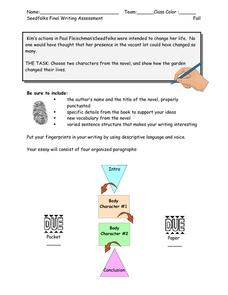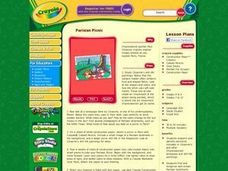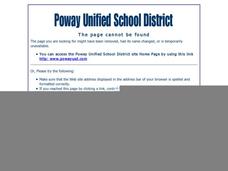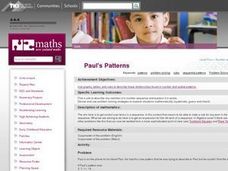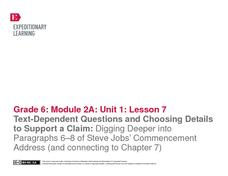National Gallery of Canada
Taken Out of Perspective
Art does not always have to look perfectly realistic. Play with proportion and shape by stretching images. Pupils study works of art by Picasso, Cézanne, and Monet before selecting a photograph to adapt. They use a distorted grid to...
Curated OER
Seedfolks Final Writing Assessment
Wrap up a study of Seedfolks with a final essay. Writers can draft their essays by following the steps and filling in the organizer provided here. The packet begins with a prompt, includes a few basic requirements, and provides an...
Curated OER
Parisian Picnic
Students investigate the artwork and life of Paul Cezanne with the help of resources to find information about the Impressionist movement. They sketch a picnic drawing as a copy of Cezanne or use the principles to create an original idea.
Curated OER
"Knot" the Whole Truth: Writing a Modern-Day Story with a Tall Tale's Voice
Beyond Paul Bunyan and his blue ox, tall tales can be a great way to teach young writers about word choice and voice in their writing. Using Jerry Spinelli's Maniac Magee and the Six-Trait Writing process, they begin to write their own...
Curated OER
The Dust Bowl: Images
Introduce learners to the hardships that followed the onset of the Dust Bowl. There is a quote taken from The Dust Bowl, Men, Dirt and Depression by Paul Bonnifield followed by 10 primary-source images.
Core Knowledge Foundation
Fairy Tales and Tall Tales Tell It Again!™ Read-Aloud Anthology
Enrich a unit on fairy tales and tall tales with a set of read-aloud lessons. Second graders hone writing, vocabulary, comprehension, and literary analysis skills as they read classic stories. Complete with extension projects, discussion...
Core Knowledge Foundation
A New Nation American Independence Tell It Again!™ Read-Aloud Anthology
Sixteen lessons make up a read-aloud anthology centered around America's journey toward independence. Scholars hear texts about the Boston Tea Party, Betsy Ross, the Found Fathers, the Liberty Bell, and more! Pupils discuss their...
Curated OER
Famous Quotes and Mottos
Students read about the accomplishments of John Paul Jones and the Continental Marines. They explore famous quotes and mottos, i.e. "Semper Fidelis." Students discuss other quotes or mottos by famous people in history. They discuss...
Curated OER
Meet the Children of the Getty: A Set of 8 Activities
Students participate in eight activities designed to examine the many students represented in artworks at the J. Paul Getty Museum. They draw, identify shapes and patterns, analyze paintings and make personal connections with their own...
Curated OER
The 'Capital' of the World
Students are introduced to the purpose of the World Bank and its president Paul Wolfowitz. After reading an article, they work together to complete a writing exercise in which they use primary source documents to state their viewpoint. ...
Curated OER
The Notorious Hope Diamond: What Makes an American Legend?
Learners view and discuss a video on the legend of the Hope Diamond then compare and contrast other tales such as Paul Bunyan, Pecos Bill and Johnny Appleseed. They analyze basic characteristics of these legends then use descriptive...
Curated OER
Microclimates of Our School
Students read the story "Weslandia" by Paul Fleischman, define the term microclimate, gather and record data in various places on school grounds to establish the presence of difference microclimates, analyze and compare microclimates,...
Curated OER
Tricks of the Trade A Collection of Concrete Poems-for writing concrete poems
Students explore concrete poetry. In this lesson about poetry, students read A Poke in the I, by Paul B. Janeczko, and are introduced to concrete poems. Students read several different kinds of concrete poems including single-word, and...
Curated OER
What's the Real Story?
Second graders investigate tall tales. In this literature lesson, 2nd graders complete a story element worksheet based upon the tall tale of Paul Bunyan. Students create a PowerPoint presentation about a tall tale.
Curated OER
American Revolution
While just an outline for an exploration of the American Revolution, this lesson could be augmented to provide a richer experience. The activity calls for learners to discuss the Declaration of Independence, study Paul Revere's midnight...
Curated OER
J. Paul Getty Museum
Young scholars read mythological Greek and Roman stories. In this mythological lesson plan students read mythological stories about Greek and Roman times. As they read, they compare the written story to the visual art of the story.
Curated OER
Paul's Patterns
Fourth graders listen to the problem. As the students work ask them questions that require them to describe the patterns in their own words.
If the students are having problems with finding the patterns encourage them to explore the...
Curated OER
Seedfolks Journal Entry Choices
Keep your class thinking about Seedfolks after they read each chapter by requiring them to keep a journal about the story. Hand out these journal entry prompts at the beginning of the story so that your learners know what to expect. For...
Curated OER
Descriptive Writing Using the Book Rumpelstiltskin
Use the fairy tale Rumpelstiltskin to teach your third grade class about descriptive writing. Following a teacher read-aloud of the story, the class brainstorms a list of adjectives describing the main character. Students use this list...
Pottsgrove School District
Tall Tales
Young readers compare and contrast digital and print versions of tall tale text. The resource includes a character analysis in which pupils compare and contrast traits, and make inferences about what the characters do and say. They...
E Reading Worksheets
Tone Worksheet 5
A speaker's attitude toward his or her subject matter determines the tone of a piece of literature. Interpret the tone of four different poems, as well as their meanings, with supporting textual details.
EngageNY
Text-Dependent Questions Text-Dependent Questions and Making a Claim: Digging Deeper into Paragraphs 12–14 of Steve Jobs’ Commencement Address (and connecting to Chapter 9)
Readers draw connections between Bud, Not Buddy and Steve Jobs' 2005 Stanford University commencement address and cite evidence from the two texts to support their analysis.
EngageNY
Getting the Gist: Steve Jobs Commencement Address (Focus on Paragraphs 6-8, and connecting to Chapter 6)
As part of a unit study of Bud, Not Buddy, readers compare Buddy's list of rules to live by with those that Steve Jobs enumerates in his commencement address to Stanford's 2005 graduating class.
EngageNY
Text-Dependent Questions and Choosing Details to Support a Claim: Digging Deeper into Paragraphs 6–8 of Steve Jobs’ Commencement Address (and connecting to Chapter 7)
Readers learn how to choose specific details drawn from a primary source (Steve Jobs' 2005 Stanford University commencement address) to support an analysis of informative text.



